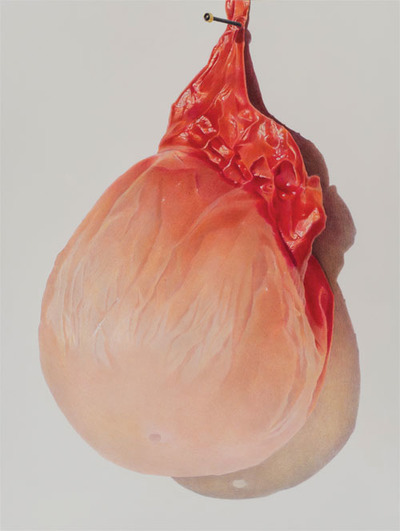ORAL FIXATIONS: DRAWINGS BY JULIA RANDALL
Beauty is an uneasy thing. It can enchant and frighten in equal measure, and Julia Randall’s drawings are replete with both effects. The puzzle here is that their nominal subjects should render them harmless. Like the 18th-century Chardin painting of a bubble blower, these inflated pieces of gum, with all their charm of virtuoso technique, might be expected to provoke only the quiet laughter of recognition.
Yet there is no escaping the unnerving paradox of these works. Although they have none of the literally grotesque that attaches to Géricault’s studies from the morgue, or Soutine’s dead stingray, there is still a hint of dissection about them, with their textures resembling the sheath of the heart, a placental sac or a womb. Several of these forms are shown pinned, as if for display in a museum of bizarre anatomical specimens, while others are stretched and partially severed by bright metal dental probes.

Julia Randall, Pinned Apricot, 2012, colored pencil on paper. Courtesy of the artist.
Yet these unsettling associations are accompanied by the splendor of what is really a catalogue of breathing, with each exhalation a memorial object that is not limited to the last one taken. Rather, the drawings collectively register the wonder of every breath from the first on, as if respiration had an illustrated calendar.
This same insight becomes animated in the artist’s video entitled Sticky, shown here. In it, bubbles emerge out of the dark, expanding and contracting like tiny antique respirators or eyeless, ephemeral puppets whose operators’ hands desperately clutch at words. That same desperation haunts the literal mouths taken from the drawing series, “Lures.” Here, the breath’s avenue is also the word’s exit, in a mute, comic gasping for something to say. Within these tongue-filled interiors, the voice is not audible, but tactile.
In several of these drawings mouth bubbles glisten with transcendent spit, curving across the surface like one of Vermeer’s convex mirrors. In the small nooks of skin, penciled details reveal lace and pearls of saliva. All of them are remarkable, yet one that especially stands out is Dandelion, where the bubble is a globe inside which all creation sits, and we, in the words of a medieval German mystic, are like “a feather on the breath of God.”
